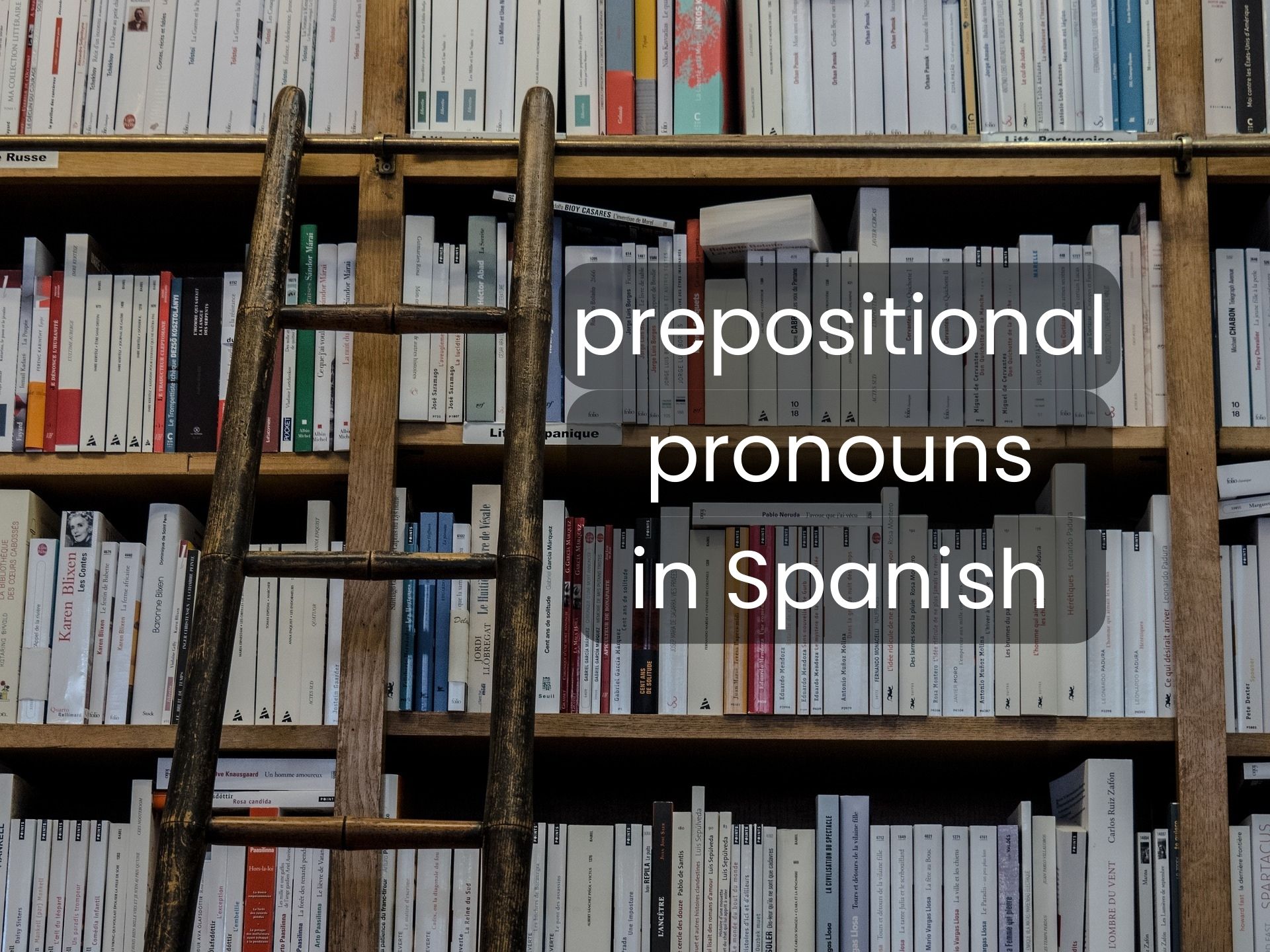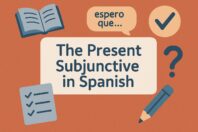Prepositional pronouns in Spanish: What you need to know

Get our free email course, Shortcut to Conversational.
Have conversations faster, understand people when they speak fast, and other tested tips to learn faster.
More infoIn today’s post, we are going to do a deep dive into prepositional pronouns in Spanish. Once we’ve done a quick refresher on prepositions and on personal pronouns, we’ll get straight to the point with a full list of the prepositional pronouns in Spanish.
We’ll focus on when to use the prepositional pronouns, which is basically after most prepositions. Then we’ll learn the exceptions, essentially looking at cases where we need to use other Spanish pronouns with certain prepositions.
Mafalda explains the most important concepts in this six-minute video, so it’s a good place to start. Or read on for the full lesson that also includes additional details on the neuter prepositional pronoun ello, as well as the reflexive prepositional pronoun sí. We’ll round out our lesson here with a few practice exercises, so you can see how well you’ve learned how to use the prepositional pronouns in Spanish.
Personal pronouns in Spanish
Before we get into the prepositional pronouns, let’s just make sure we’re clear on what is a pronoun in the first place: a pronoun is a word that is used as a substitute for a noun or phrase that was previously mentioned.
There are many types of pronouns, but the most important ones are the various personal pronouns. Let’s start with a simple example of how a personal pronoun works:
- Ana is an excellent student. She learns new things every day. – Ana es una estudiante excelente. Ella apriende cosas nuevas cada dia.
In this example, the personal pronoun she is used as a substitute for the original noun Ana. It’s a subject pronoun, since it acts as the subject of the sentence. Other categories of personal pronouns include direct object pronouns, indirect object pronouns, reflexive pronouns, and prepositional pronouns.
Prepositions in Spanish
We’ve just reviewed what a pronoun is. But what is a preposition?
A preposition is what we use to indicate the relationship between two words or phrases. Prepositions often express how these words are connected in terms of location, direction, or time.
Here are some of the most important prepositions in English, with their Spanish equivalents. Just keep in mind that the translations aren’t always exact between languages, depending on how a given preposition is being used.
| Preposition, English | Preposition, Spanish |
| on | en, sobre, encima |
| above | sobre, encima de |
| across from | a través de |
| to | a |
| of | de |
| for | por, para |
| with | con |
| without | sin |
Prepositional pronouns in Spanish
Prepositional pronouns are the personal pronouns that appear after a preposition. A prepositional pronoun acts as the object of that preposition.
Let’s see a simple example: “the light is above me.” The preposition is above, and the prepositional pronoun is me.
To use prepositional pronouns in Spanish, we first need a preposition, and then we follow it with the prepositional pronoun that corresponds with the noun, person, or thing we’re referring to.
Now we’re ready to see all of the Spanish prepositional pronouns.
| Subject pronoun, Spanish | Prepositional pronoun, Spanish | Prepositional pronoun, English |
| yo | mí | me |
| tú | ti | you |
| usted | usted | you (formal) |
| él | él | him |
| ella | ella | her |
| nosotros | nosotros | us |
| nosotras | nosotras | us (feminine) |
| vosotros | vosotros | you (plural) |
| vosotras | vosotras | you (plural feminine) |
| ustedes | ustedes | you (plural) |
| ellos | ellos | them |
| ellas | ellas | them (feminine) |
You’ve probably noticed that most of the prepositional pronouns in Spanish are identical to the subject pronouns. Only me (mí) and you (ti) are different, so these are the best ones to use when we’re demonstrating our lesson.
Note that the prepositional pronoun mí has an accent, whereas its unaccented homophone mi is the possessive adjective meaning my.
- Those two people are working for me. – Esas dos personas trabajan para mí.
- The new student is seated next to you. – El estudiante nuevo está sentado al lado de ti.
- The present is for me. – El regalo es para mí.
- My mum always talks about you. – Mi mamá siempre habla de ti.
For a bunch of other contexts where you’ll need to use the prepositional pronouns, check out our related post that introduces common Spanish verbs used with prepositions.
Prepositional pronouns in Spanish: The exceptions
There are a few sets of exceptions when the regular prepositional pronouns we just listed won’t be used. Let’s see each one.
Prepositions followed by subject pronouns
As we’ve seen so far, most Spanish prepositions trigger the use of prepositional pronouns after them. However, there are a few specific Spanish prepositions that are exceptions to this rule. All of these exceptions are listed here. When we use any of them, they’re followed by yo and tú rather than mí and ti.
| Preposition, Spanish | Preposition, English |
| entre | between |
| excepto | except |
| hasta | including |
| incluso | even, including |
| menos | except |
| salvo | except |
| según | according to |
- The problem is between you and me. – El problema es entre tú y yo.
- Everyone will attend the meeting except for you and them. – Todo el mundo irá a la reunión excepto tú y ellas.
- The party was at Daniela’s place. Everyone was having a blast except me. – La fiesta fue en la casa de Daniela. Todo el mundo la estaba pasando genial salvo yo.
- Many people believe in Santa Claus, including me. – Muchas personas creen en San Nicolás, hasta yo.
Conmigo (with me) and contigo (with you)
For phonetic reasons, when we use the preposition con, meaning with, along with the prepositional pronouns mí or ti, we replace the whole prepositional phrase with conmigo and contigo. The meaning remains the same.
- Do you want to dance with me? – ¿Quieres bailar conmigo?
- They will go with you to Panama, won’t they? – Ellos irán contigo a Panamá, ¿cierto?
- Ernesto and her sister are training with me. – Ernesto y su hermana están entrenando conmigo.
Ello as the neuter prepositional pronoun
Normally in Spanish, our third-person singular pronouns are either él or ella, meaning he or she: there’s no neuter it pronoun in Spanish. In rare circumstances, however, we can use ello as a neuter prepositional pronoun in Spanish. This only works when we’re referring back to an abstract concept rather than a Spanish noun with a specific gender.
- It was too windy and rainy. Without it, we would have hiked all day. – Hacía demasiado viento y lluvia. Sin ello, hubiéramos caminado todo el día.
- I’ve been dreaming of sun and waves. After that, I booked a surf trip to Sayulita. – He estado soñando con el sol y las olas. Después de ello, reservé un viaje de surf a Sayulita.
Keep in mind that the neuter pronoun ello is quite uncommon in contemporary Spanish. Instead, it’s more common to use the neuter demonstrative pronoun eso in such sentences, which just translates as that.
Sí used as a reflexive prepositional pronoun
When the subject of a sentence is the same as the object of the preposition, we can consider that the verb’s action is being applied reflexively. For all third-person subjects, whether singular or plural, we use sí as the reflexive prepositional pronoun in these contexts.
In this case, sí can mean himself, herself, itself, yourself, themself, yourselves, or themselves.
- Melissa bought a new house in Buenos Aires for herself. – Melissa compró una casa nueva en Buenos Aires para sí.
We cover this use in more detail in our post on sí in Spanish. This is the least common exception to our use of prepositional pronouns, since native speakers will typically use reflexive verbs to convey the same idea:
- Melissa bought herself a new house in Buenos Aires. – Melissa se compró una casa nueva en Buenos Aires.
Conclusion: The Spanish prepositional pronouns
Today we took a close look at the prepositional pronouns in Spanish.
Once we were clear on what we mean by both prepositions and pronouns, we got into our lesson on the prepositional pronouns.
In short, these constitute a category of personal pronouns in Spanish that are used as the object of prepositions. Most of them are identical to the subject pronouns, except for mí and ti.
Their use is mostly straightforward, since they’re just used after Spanish prepositions. However, a few prepositions don’t trigger the use of these prepositional pronouns, and there are also a few contexts where we use other pronouns after prepositions. We saw each of these exceptions, so now you know everything you need about how to use the prepositional pronouns in Spanish!
With that, we’ll leave you with a set of exercises to see how well you’ve understood the use of prepositional pronouns in Spanish. They should be easy for you! – ¡Deberían ser fáciles para ti!
Prepositional pronouns in Spanish: Exercises
Choose the correct prepositional pronoun in each sentence.
1. Luis y yo queremos ir contigo / conmigo / con nosotros a la fiesta. – Luis and I want to go with you to the party.
2. Los zapatos azules y la camisa de cuadros son para mi / mí / tú. – The blue shoes and the plaid shirt are for me.
3. Según ti / contigo / tú no existen los duendes. – According to you, elves do not exist.
4. Entre contigo y conmigo / tú y mí / tú y yo, esta fiesta está aburridísima. – Between you and me, this party is boring.
5. Todos quieren conocer sus cantantes favoritos, excepto ella y yo / ella y mí / ella y ti. – Everyone wants to meet their favorite singers, except her and me.
6. Ellos deberían aprender a confiar más en nosotros / tú / contigo. – They must learn to trust us more.
7. Mi mamá siempre me decía que podía contar con él / nosotros / ella. – My mom always told me that I could count on her.
8. Los niños no querrán despedirse de usted / yo / tú. – The kids won’t want to say goodbye to you.
9. Nancy estaba hablando tú y yo / conmigo / ti y conmigo cuando recibió la llamada de su amiga. – Nancy was talking to me when she received the call from her friend.
10. Ellos se han olvidado de ti y de mí / tú y yo / contigo y conmigo. Por eso estoy tan triste. – They have forgotten about you and me. That’s why I’m so sad.
Answers
1. Luis y yo queremos ir contigo a la fiesta.
2. Los zapatos azules y la camisa de cuadros son para mí.
3. Según tú no existen los duendes.
4. Entre tú y yo, esta fiesta está aburridísima.
5. Todos quieren conocer sus cantantes favoritos, excepto ella y yo.
6. Ellos deberían aprender a confiar más en nosotros.
7. Mi mamá siempre me decía que podía contar con ella.
8. Los niños no querrán despedirse de usted.
9. Nancy estaba hablando conmigo cuando recibió la llamada de su amiga.
10. Ellos se han olvidado de ti y de mí. Por eso estoy tan triste.



